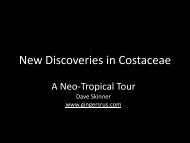BULLETIN - Heliconia Society International
BULLETIN - Heliconia Society International
BULLETIN - Heliconia Society International
Create successful ePaper yourself
Turn your PDF publications into a flip-book with our unique Google optimized e-Paper software.
PAGE 14 THE <strong>BULLETIN</strong> / MAY JANUARY 2009 2005<br />
Curcuma longa: Passing on traditional<br />
Kosraean knowledge (with a<br />
note on banana soup)<br />
Roxina Filrang<br />
in association with James Skouge, University<br />
of Hawai’i, jskouge@hawaii.edu<br />
Roxina Filrang is from the island of Kosrae in the Federated<br />
States of Micronesia (FSM), and has a particular<br />
interest in medical ethnobotany of Micronesia. She<br />
earned a Bachelor of Science degree in Botany from the<br />
University of Hawai`i – Manoa (U.H.) in December 2007,<br />
and is now a graduate student at U.H. She is a member<br />
of Pacific Voices, (a team headed by Dr. James Skouge,<br />
headquartered in the U.H. College of Education, Department<br />
of Special Education), which promotes the ethical<br />
uses of technology to “give voice” to indigenous peoples<br />
of the Pacific to honor and preserve language and culture,<br />
especially as related to health and education.<br />
Kosrae is a relatively<br />
isolated island without many<br />
visitors or immigrants. This<br />
verdant island is 42 square<br />
miles in size, with a population<br />
of 8,000 people. Archaeologists<br />
believe that our “first<br />
people” arrived sometime<br />
around the first millenium,<br />
constructing a complex matrilineal<br />
society that survived<br />
until Western contact. Whalers and<br />
buccaneers began arriving in the<br />
early 1800s, introducing epidemic<br />
diseases (including syphilis and tuberculosis)<br />
– diminishing our population<br />
from perhaps 10,000 to just a<br />
few hundred by the end of the 19 th<br />
century. The first missionary station<br />
was built in 1852 and we were<br />
Christianized soon thereafter. We<br />
were ruled by the Japanese from<br />
1914 to 1945; and then became a<br />
“trust territory” of the United States.<br />
On July 12, 1978, the peoples of Truk (now Chuuk), Yap,<br />
Ponape (now Pohnpei) and Kusaie (now Kosrae) voted to<br />
form the sovereign nation of the FSM. We remain connected<br />
with the United States, however, through a<br />
“compact of free association.” We are considered to be a<br />
very religious and hospitable people.<br />
I was born in 1983 in Pohnpei, FSM. My mother<br />
is Kosraean and my father Pohnpeian. When I was two<br />
weeks young, my parents sent me to Kosrae to be raised<br />
by my grandparents, which was and still is a very<br />
“island” thing to do. I experienced a joyous childhood<br />
growing up in Tafunsak village on this tiny island,<br />
blessed by the unconditional love of my grandparents,<br />
both of whom had been born and<br />
raised in Kosrae. They lived on<br />
our ancestral lands. Our plantation<br />
provided sustainable crops,<br />
and the ocean was our refrigerator.<br />
I learned indigenous values (a<br />
term I was later to learn in college)<br />
from my grandparents.<br />
These values include faith and<br />
humility, respect for elders, and<br />
sacredness of land and ocean.<br />
Kosraeans are “naturalists.” They<br />
live off the land and ocean. We<br />
Roxina Filrang at the village<br />
of Miloli`i on the Big<br />
Island of Hawai`i<br />
Island of the Sleeping Lady, Kosrae<br />
Rainforest, Kosrae<br />
are skilled with our hands. We<br />
fish and farm. We depend upon<br />
natural resources for food, shelter<br />
and medicine. As a child I observed<br />
my grandmother harvesting<br />
plants and their extracts,<br />
which she would mix with<br />
oil and other ingredients<br />
and then apply to cuts or<br />
boils and other ailments. I<br />
learned from my grandparents<br />
that we should share<br />
our gifts to help anyone in<br />
need – but this sacred<br />
knowledge should be kept<br />
within the family.<br />
These events had a great impact<br />
on me. Although I was young at<br />
the time, I did realize that they<br />
trusted me and wanted me to understand<br />
the significance of what<br />
they were teaching me. From<br />
them I experienced the traditional<br />
island ways of teaching and learning<br />
through modeling, observation<br />
and hands-on experience. The<br />
natural environment was our<br />
classroom without walls. I also<br />
experienced Western ways of<br />
learning at our village school. In the United States, education<br />
is often defined as something that is gained by<br />
reading, and I appreciated the value of books (although<br />
we didn’t have many). I decided early on that I wanted<br />
one day to live in Hawai`i and attend the university. For<br />
us, though, the problem is that our history, knowledge


